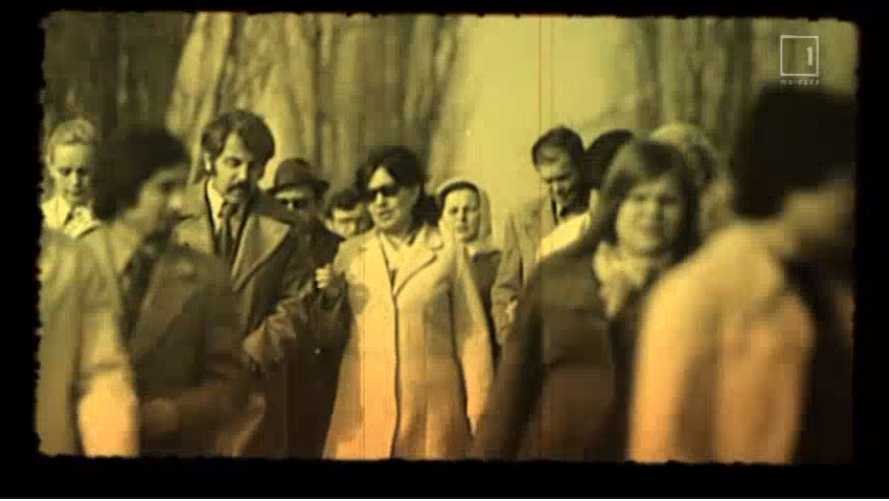
According to the latest Court of Accounts audit at Teleradio-Moldova, the company did not take “sufficient actions for proper record-keeping, evaluation, and transmission of the radio and TV reserve collection to the state archive.” The auditors say that they have previously reported this backlog, including the fact that the reserve collection was not included in the Register of Mobile National Cultural Heritage. To date, the Court’s findings and recommendations on this situation “have not been remedied and implemented,” the audit report says.

From the TRM audiovisual archive. Photo source: Moldova 1
The TRM administration claims that it has partially digitized the archive, on some servers purchased a few years ago by the company and kept in a data center.
At the July 27 meeting of the Court of Accounts, where the audit was discussed, TRM General Director Olga Bordeianu said that the institution is ready to transfer the collection to the state archive, but it is necessary to create a special register to establish the transmission procedure. “Unfortunately, it’s not just about TRM, it’s a pretty broad process. I know that in 2019, several meetings took place and this register was drawn up. Unfortunately, TRM is not in it,” Olga Bordeianu explained.
IN SEARCH OF FUNDS
According to her, the process of digitizing and cataloging the archive is expensive. “We have very great achievements on the radio; practically 100% of the Radio Moldova archive is already digitized. It remains, including with the support of the Parliament and the Government, to digitize the archive of Moldova 1 and Moldova 2. There we have materials that are still kept on magnetic tapes and VHS tapes and are to be digitized because their warranty expires and we risk losing everything, especially what is stored on magnetic tapes, which have already begun to wear away. Unfortunately, we do not have enough funds to make big changes,” Olga Bordeianu said at the meeting of the Parliamentary Commission for Control of Public Finances.

From the TRM audiovisual archive. Photo source: Moldova 1
Adrian Lebedinschi, chairman of the Parliamentary Commission for the Media, confirms that solving the problem requires money. “We will give all possible input to keep the archive and digitize it. It all depends on finances. (...) If there are certain funds, we’ll identify them and, if additional money is needed, we are open to work on it,” the parliamentarian told Media Azi.
He claims that the problem of digitizing audiovisual funds concerns Moldova-Film, the National Archive, and the National Center of Cinematography, which, according to the legislation, should also have two subdivisions – the National Film Archive and the Cinematographic Register. The MP claims that this storage has not yet been created at the Center due to lack of money, and discussions are currently being held with Russian partners in order to obtain financial sources.
THE MINISTRY POINTS AT TRM
The Ministry of Education, Culture, and Research (MECR) claims that the owner is the one that should remedy the situation regarding the evaluation and inclusion of the TRM’s radio and TV collection in the Register of Mobile National Cultural Heritage. An official response to Media Azi says that Teleradio-Moldova, according to the legislation, “is responsible for keeping and archiving audiovisual recordings and documents of interest to the national heritage; therefore, it should inventory and initiate the procedure for filing away the assets held.”
Only then, “given the files proposed for filing away and based on the reports prepared by experts accredited by MECR, following the decision of the National Commission of Museums and Collections, the ministry will issue the order to file away the cultural assets and register them in the Register of Mobile National Cultural Heritage in the categories Treasure or Fund,” says the letter signed by the Secretary of State for Culture, Andrei Chistol.
THE NATIONAL ARCHIVE COMPLAINS ABOUT LACK OF PEOPLE
In her turn, the head of the Cinematographic and Audiovisual Documents Department within the National Archive Agency, Parascovia Polișciuc, blames the fact that the institution does not have enough staff to process all the materials it has to archive. She claims that, due to the lack of specialists, nothing has been done in this regard in the last five years.

National Television Museum. Photo source: Moldova 1
According to her, the radio and TV collection of TRM for the years 1998-1999 was sent to the National Archive in its entirety. Subsequently, the management of Teleradio-Moldova allegedly told them that it no longer had sufficient means to make the inventory. “In 2008 or 2009 we addressed them and said that they have to send everything – radio and TV programs – but there is a lot of publicity, and we do not have employees at the moment. This year, we barely hired two people. Next year, we plan to resume the process of taking over the sound documents with TRM,” Polișciuc told us. She believes that the decision of the Court of Accounts will speed up the archiving process.
THEVALUE OF THE HERITAGE HELD BY TRM
TRM representatives claim that the company’s archive contains “an invaluable heritage,” which “preserves the history of popular culture and traditions.” The oldest film dates back to 1936, and the oldest video recording is from 1982. According to the data from the accounting records, the value of the radio and television recordings collection reaches almost ten million lei.

Photo source: Moldova 1

Photo source: Moldova 1
“We use these archives, but in an inappropriate, primitive way, because they are not digitized. There is a device with which we project on the screen, and from the screen, we film on camera. There is no other solution,” he adds.

Photo source: Moldova 1










